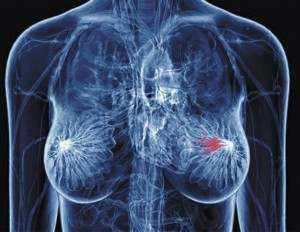By David W. Feld, MD, Jupiter Obgyn –
 Breast cancer is a cancer that starts in the tissues of the breast, and is predominately divided into two main types: ductal and lobular.
Breast cancer is a cancer that starts in the tissues of the breast, and is predominately divided into two main types: ductal and lobular.
Ductal carcinoma is initiated in the ducts, or tubes, which are the parts of the breast that move milk from the breast to the nipple. Most cancers of the breast originate here.
Lobular carcinoma starts in the milk-producing tissue, known as the lobules.
Both of these lesions can be classified as either invasive or non-invasive. Invasive indicates that it has spread from the duct or lobule to other tissues in the breast. If it is non-invasive, also called “in-situ”, that means no spread has occurred and the survival rates are much better.
BREAST CANCER TODAY:
The most recent news is not very encouraging. Approximately 1 in 8 women, or about 12%, will develop invasive breast cancer in their lifetime. Last year, about 300,000 new cases were diagnosed in women, and 2,000 new cases in men. Men now face a risk much higher than years ago, with an incidence of 1 in 1,000 in their lifetime.
From 1999 to 2005, breast cancer incidence dropped by about 2% per year in women 50 years or older. This was due, in part, to the reduced use of hormone replacement therapy (HRT) after the study called the Women’s Health Initiative published in 2002, which suggested a connection between HRT and an increased incidence of breast cancer.
In last month’s Journal of the American Medical Association (JAMA), it was reported that more women under 40, than ever before, are being diagnosed with breast cancer. In 1976, 1.53 out of every 100,000 American women 25 to 39 years old had advanced breast cancer. By 2009, the rate was 2.9 per 100,000 women in the same age group– almost double. This is statistically significant and must be addressed. Let’s see how.
BREAST CANCER RISK FACTORS:
The most significant risk factors are gender, being a woman, and age, or growing older. Other factors include genetic risk factors, family history, personal history of breast cancer, race and ethnicity, breast tissue density, birth control, HRT, breastfeeding, alcohol, obesity, physical activity, diet, tobacco use, environmental chemicals, and vitamins.
PREVENTION: LIFESTYLE AND CAROTENOIDS
It has been said that “genetics loads the gun and lifestyle pulls the trigger”. What is about to be said about breast cancer prevention, can well be applied to the top three illness we face every day: cancer, diabetes, and heart disease, as well as every other immune-deficient malady.
1) Don’t Smoke! Smoking is the single most effective way to damage cellular health, and accumulating evidence shows a large increase in breast cancer in premenopausal females who merely are social smokers, not to mention lung cancer, pulmonary disease, heart disease, and the list goes on!
2) Limit Alcohol Usage: The more alcohol imbibed, the greater the risk. Simply enjoy limited usage to no more than one drink per day.
3) Weight control: Almost 70% of Americans are obese or overweight, and there is a direct correlation between this and cancer.
4) Physical Activity: The Department of Health and Sciences recommends 150 minutes of moderate exercise weekly, which helps control your weight, and in turn reduces your risk for disease.
5) Breast Feed: The longer you nurse, the greater the protective effect.
6) Limit HRT: The use of HRT, and that includes Bioidenticals, for more than three to five years, increases the incidence of breast cancer. Find non- hormonal alternatives,if possible, but if you must use HRT, it is recommended that you titrate down to the lowest dosage for the shortest period of time.
7) Radiation and Environmental Pollution: Obviously, reduce your exposure to medical-imaging methods, chemicals in the workplace, and overall pollution such as exhaust fumes.
8) Healthy Diet: Poor nutrition, more than ever, is being tied to diseases of all organ systems. Eating a healthy diet rich in vegetables, and berries, and even juicing, has shown a reduced incidence of heart disease, diabetes, cancer and the like.
9) HIGH LEVELS OF CAROTENOIDS TIED TO REDUCED BREAST CANCER INCIDENCE:
In December, 2012, Harvard University published a revolutionary article in the “Journal of the National Cancer Institute”, which concluded that women with “higher circulating levels of alpha-carotene, beta-carotene, lutein, zeaxanthin, lycopene, and total carotenoids” are at a significantly lower risk for cancer of the breast. There is no longer any room for doubt. Furthermore, just to be clear, the word vitamin was not used. It’s all about that buzzword “antioxidants”, of which “carotenoids” are the strongest protection for your immune system, and the most important measurement. While this study measured blood levels, we can now measure with an instrument as seen on Dr. Oz.
As mentioned before, I challenge my patients to fight back. We can do this with a healthy diet, a reasonable lifestyle, and antioxidant supplementation that is measurable and guaranteed to improve the odds of living longer and healthier.
Jupiter OBGYN
David W. Feld, MD
210 Jupiter Lakes Blvd, Suite 101
Jupiter, FL 33458
561-747-3777
Check Also
Physical Therapy for the Brain
Have you noticed you have difficulty hearing your family and friends in a noisy restaurant? …
 South Florida Health and Wellness Magazine Health and Wellness Articles
South Florida Health and Wellness Magazine Health and Wellness Articles




